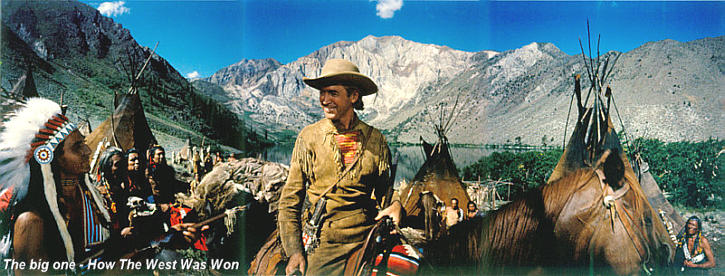|
| cinerama |
|
Now it happens that the original
specs for Ultra-Panavision (70mm
with a 1.25 squeeze) yield the
same aspect ratio as Cinerama
(2.76), and 3-panel prints could
be made from the negative,
although this has never been
done. (Imagine the chariot race
from Ben-Hur projected this way!)
Worse, Reisini also called a halt
to all R&D, which stopped
production of Waller’s design of a
16-perf pull-across camera with a
curved gate, and curved real
element lens. Three-panel prints
would be made from the single
negative, forever solving the
image kinking problem where the
panels (each with its own
vanishing point) met. Waller had
never stopped trying to improve
the process, and had always seen
3-panel as first generation
technology. He would know none
of the fate of his brainchild,
however. He passed away in
1954, just days after receiving an
Academy award for Cinerama.
The Cinerama name rapidly lost
its cache and market share.
Theaters were un-converted to
conventional projection. Of the
several purpose-built “Super
Cinerama” theaters, only a few
remain, and only two, the Seattle
Cinerama and the Cinerama
Dome in Hollywood, are
equipped to show 3-panel films.
(The Cooper in Denver, Colorado
was recently demolished for a
parking lot despite its listing on
the National Register of Historic
Places.) The company assets and
distribution arm were purchased
by Pacific Theaters, which
mothballed the equipment and
sold the remaining prints as
sound spacer.
The last presentation of 3-panel
projection was at a festival in
Paris in 1972. As late as 1976,
Lowell Thomas was still trying to
revive interest in the process for
the nation’s bicentennial. He
firmly believed that someday,
someone would help Cinerama
achieve its potential. And so it
languished, presumed dead, for
nearly 20 years.
The Cavalry Arrives
In 1983, American
Cinematographer Magazine
commissioned a 20th anniversary
retrospective article on How The
West Was Won. Appearing in the
October issue, it celebrated
Cinerama and mourned its
passing.
This caught the eye of retired
projectionist John Harvey, who
decided he would bring back
Cinerama “if I have to do it by
myself.” He ferreted out three
projectors and a sound head and
installed a full working Cinerama
theater – in his home. At first he
only had 4 minutes of footage.
Gradually, he cobbled together a
print of TIC and one of HTWWW,
the latter in IB Technicolor. Eventually he acquired a pristine,
but faded Eastman print of
Cinerama Holiday. These he
happily shared with the British
Museum of Photography and Film
in Bradford, England beginning in
1993. For years this was the only
place on the planet where
Cinerama could still be seen.
In 1996, Larry Smith, manager of
the small art house cinema, The
New Neon in Dayton, Ohio,
convinced Harvey to move his
equipment there. And so began
the renaissance of ‘ole 3-eyes.
Press attention brought people
from all over the world to see the
process they thought was lost
forever.
Not long after, Paul Allen saved
the Seattle Cinerama Theater
from the wrecking ball, and
restored it to its full 3-panel glory,
ordering new prints of TIC and
HTWWW.
 Much of the continuing interest in
saving Cinerama can be traced to
the efforts of Dave Strohmaier,
who has spent 5 years
researching the process, and
collecting memorabilia and
interviews with surviving cast and
crew for his documentary, The
Cinerama Adventure. A labor-of-love
project, it is now being
completed with the help of the
American Society of
Cinematographers and Laser
Pacific.
Much of the continuing interest in
saving Cinerama can be traced to
the efforts of Dave Strohmaier,
who has spent 5 years
researching the process, and
collecting memorabilia and
interviews with surviving cast and
crew for his documentary, The
Cinerama Adventure. A labor-of-love
project, it is now being
completed with the help of the
American Society of
Cinematographers and Laser
Pacific.
The original film materials for all
the travelogues have been vaulted
for decades. Fading as we speak,
they are awaiting restoration – if
only someone will put up the
money.
And what of the Cinerama Dome in
Hollywood? Nearly lost in a
planned conversion to flat-screen
and buried inside a parking
structure, the Dome was saved
largely through the efforts of the
Los Angeles Conservancy under the
direction of Doug Haines’ Friends
of Cinerama. This is quiet
vindication for John Sittig, long
time Pacific Theaters manager, who
has been quietly lobbying behind
the scenes for years to install
Cinerama in the Dome.
This fall, it happened at last. Made
at the order of Michael Forman,
head of Pacific Theaters, a new
print of This Is Cinerama, struck
from the original negative by Crest
Lab, was shown on September 30th ,
the 50th anniversary of the original
premier in New York. This marked
the first time 3-panel has ever been
shown in the Dome. In October, a
40th anniversary re-premier of How
The West Was Won is planned.
This will be welcome news for
millions of baby boomers for whom
Cinerama is a cherished childhood
memory of an utterly unique
experience they’ve been denied for
over 40 years. Come September,
they’ll all feel a bit like Lillith
Prescott toward the end of
HTWWW, when she is joyfully re-united
with her family after
decades of separation.
“Oh my,” she gently weeps, “I
swore up and down I wasn’t going
to cry.”
|
|